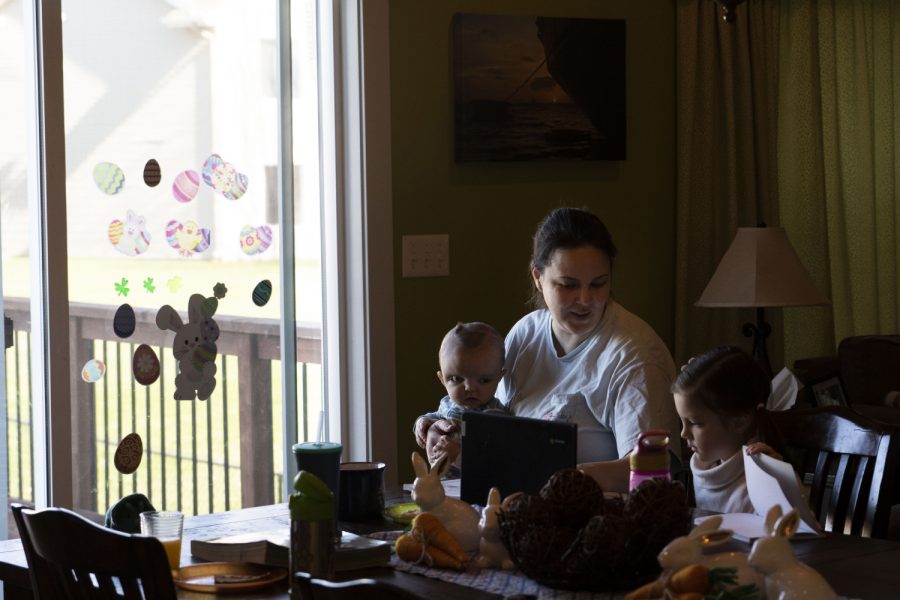Laura Greenwood sits at her kitchen table with her daughter Bridget, seven, and son Reid, one, on Thursday, April 1, 2021. “The beginning of the pandemic was scary, very scary.” Greenwood said. “We were expecting a baby and there was a lot of uncertainty.”
Finding support where they can
May 10, 2021
Aislinn Conrad loved her life before the COVID-19 pandemic. She had a thriving social life, work as an assistant professor in the University of Iowa School of Social Work she loved going to, and full-time daycare for her 4-year-old and 7-year-old sons, who she splits custody 50/50 with her co-parent. After her “last good weekend” before the UI’s 2020 spring break, she said she lost her whole support system.
The daycare closed. School sent the kids home. Friends were worried about mingling with other families. And Conrad found herself caring for her sons while trying to work remotely full-time.
“I was in such grief and shock, and then also was caring for my kids 50 percent up and above my normal job, that I really lost the ability to function,” Conrad said. “I couldn’t work because I was just in shock, and just grief-ridden and the most depressed that I’ve ever been.”
Starting in March 2020, Conrad said she felt like she was just struggling to keep her head above water while working 80-100 hours a week between both her kids and job. She entered therapy, which she said has recently started to help her cope with her anxiety and depression. In June, Conrad and her co-parent hired a nanny to go between their homes, coming over three days a week.
By November, she found she was unable to keep going in isolation and started to loosen her own COVID-19 restrictions. Her support network — friends who helped with the kids, friends who came over just to be another adult in the house, single moms she knew — had disappeared, and she needed them back.
“I was interacting with my then-partner … my co-parent, and the nanny. And that was basically it,” she said of the three people who entered her home during this time.
In addition to bringing people back into her life, a year after the pandemic began she sent her oldest son back to school at Lucas Elementary and her younger son to daycare. This let her focus on her work and have time for herself rather than having to entertain and mediate until they went to bed, like she had been doing for the past 12 months.
Conrad’s support system has recently become stronger than ever, and she’s able to have fun with her children without the exhausting task of juggling 24/7 monitoring while working a full-time job.
“I really think it took losing everything in order for what’s really important to come into focus and to guide my existence rather than maybe what used to guide my existence, including my children, who are the most spectacular humans,” she said.
Buxton made the decision to keep herself home with her 4-year-old, first-grader, and third-grader for multiple reasons. As a teacher, she was unsure of how safe she would be in school. As a parent, it made more sense for her to stay home and use her profession to keep her kids learning, and she wasn’t sure who would be able to watch the kids while she worked. As an individual, navigating being a full-time worker and a full-time mom was daunting.
Grandparents live nearby and take her 4-year-old off Buxton’s hands once a week, but she said she knew that if she had decided to stay on at work, they wouldn’t have felt comfortable taking care of them while she worked because of concerns surrounding COVID-19.
The teachers Buxton knows who have continued to work during the pandemic have been getting support from their families to allow them to go into school or work without interruptions at home, she said.
Buxton found camaraderie in another family, whose kids come over to participate in online school and hang out with her children. She said it’s nice to give the kids some social interaction while still staying safe, and Buxton and her husband can see their parents.
“We feel so lucky that I was able to work out that I could take a year off from my job, because, like, a lot of my friends I know, weren’t able to have that convenience of doing that, or that ability to do that,” she said.
Laura Greenwood has been a stay-at-home mom since she had her first daughter in 2013. She now has three children, with her youngest son born in April 2020 with a medical condition, leaving him without an eyelid.
This has made Greenwood’s family extra cautious, which means she has three kids usually cooped up in the house or backyard and her husband upstairs in his office. While neither Greenwood or her husband’s jobs have changed because of the pandemic, she’s had to become an educator as well as a mother to her children.
With two young children and a baby, Greenwood doesn’t get much time to herself. With the pandemic making her youngest even more at risk of catching an infection, she doesn’t see other adults, either.
“Feeling like the only safe place for us to be was in these four walls was really different than I’m used to in terms of parenting,” Greenwood said.
Her support system shrunk to her parents after she had the baby, as they had already planned to come down for a while when he was born. Her mother ended up staying six weeks, helping out with the other kids and doing whatever she needed while they had to isolate.
Most of Greenwood’s friends haven’t even met her youngest, and she hasn’t had a reliable helper since her parents came to stay.
“I hope to … feel like our family and friends can become reliable helpers to us again,” she said.
